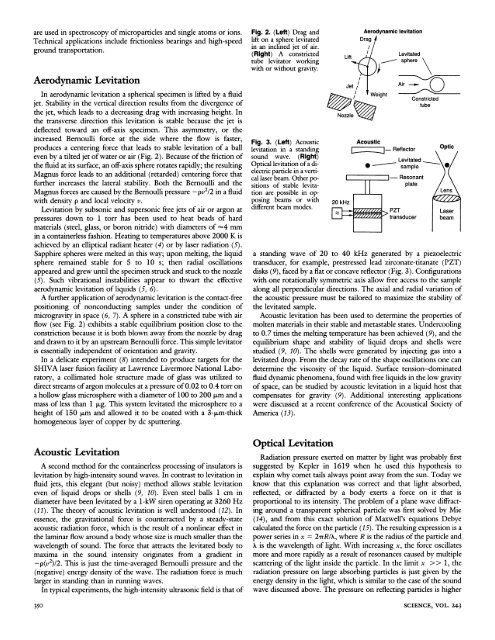Levitation in Physics
Levitation in Physics
Levitation in Physics
You also want an ePaper? Increase the reach of your titles
YUMPU automatically turns print PDFs into web optimized ePapers that Google loves.
are used <strong>in</strong> spectroscopy of microparticles and s<strong>in</strong>gle atoms or ions.<br />
Technical applications <strong>in</strong>clude frictionless bear<strong>in</strong>gs and high-speed<br />
ground transportation.<br />
Aerodynamic <strong>Levitation</strong><br />
In aerodynamic levitation a spherical specimen is lifted by a fluid<br />
jet. Stability <strong>in</strong> the vertical direction results from the divergence of<br />
the jet, which leads to a decreas<strong>in</strong>g drag with <strong>in</strong>creas<strong>in</strong>g height. In<br />
the transverse direction this levitation is stable because the jet is<br />
deflected toward an off-axis specimen. This asymmetry, or the<br />
<strong>in</strong>creased Bemoulli force at the side where the flow is faster,<br />
produces a center<strong>in</strong>g force that leads to stable levitation of a ball<br />
even by a tilted jet of water or air (Fig. 2). Because of the friction of<br />
the fluid at its surface, an off-axis sphere rotates rapidly; the result<strong>in</strong>g<br />
Magnus force leads to an additional (retarded) center<strong>in</strong>g force that<br />
further <strong>in</strong>creases the lateral stability. Both the Bernoulli and the<br />
Magnus forces are caused by the Bernoulli pressure - pv2/2 <strong>in</strong> a fluid<br />
with density p and local velocity v.<br />
<strong>Levitation</strong> by subsonic and supersonic free jets of air or argon at<br />
pressures down to 1 torr has been used to heat beads of hard<br />
materials (steel, glass, or boron nitride) with diameters of --=4 mm<br />
<strong>in</strong> a conta<strong>in</strong>erless fashion. Heat<strong>in</strong>g to temperatures above 2000 K is<br />
achieved by an elliptical radiant heater (4) or by laser radiation (5).<br />
Sapphire spheres were melted <strong>in</strong> this way; upon melt<strong>in</strong>g, the liquid<br />
sphere rema<strong>in</strong>ed stable for 5 to 10 s; then radial oscillations<br />
appeared and grew until the specimen struck and stuck to the nozzle<br />
(5). Such vibrational <strong>in</strong>stabilities appear to thwart the effective<br />
aerodynamic levitation of liquids (5, 6).<br />
A further application of aerodynamic levitation is the contact-free<br />
position<strong>in</strong>g of nonconduct<strong>in</strong>g samples under the condition of<br />
microgravity <strong>in</strong> space (6, 7). A sphere <strong>in</strong> a constricted tube with air<br />
flow (see Fig. 2) exhibits a stable equilibrium position close to the<br />
constriction because it is both blown away from the nozzle by drag<br />
and drawn to it by an upstream Bernoulli force. This simple levitator<br />
is essentially <strong>in</strong>dependent of orientation and gravity.<br />
In a delicate experiment (8) <strong>in</strong>tended to produce targets for the<br />
SHIVA laser fusion facility at Lawrence Livermore National Laboratory,<br />
a collimated hole structure made of glass was utilized to<br />
direct streams of argon molecules at a pressure of 0.02 to 0.4 torr on<br />
a hollow glass microsphere with a diameter of 100 to 200 p.m and a<br />
mass of less than 1 ,ug. This system levitated the microsphere to a<br />
height of 150 pum and allowed it to be coated with a 3-pm-thick<br />
homogeneous layer of copper by dc sputter<strong>in</strong>g.<br />
Acoustic <strong>Levitation</strong><br />
A second method for the conta<strong>in</strong>erless process<strong>in</strong>g of <strong>in</strong>sulators is<br />
levitation by high-<strong>in</strong>tensity sound waves. In contrast to levitation <strong>in</strong><br />
fluid jets, this elegant (but noisy) method allows stable levitation<br />
even of liquid drops or shells (9, 10). Even steel balls 1 cm <strong>in</strong><br />
diameter have been levitated by a 1 -kW siren operat<strong>in</strong>g at 3260 Hz<br />
(11). The theory of acoustic levitation is well understood (12). In<br />
essence, the gravitational force is counteracted by a steady-state<br />
acoustic radiation force, which is the result of a nonl<strong>in</strong>ear effect <strong>in</strong><br />
the lam<strong>in</strong>ar flow around a body whose size is much smaller than the<br />
wavelength of sound. The force that attracts the levitated body to<br />
maxima <strong>in</strong> the sound <strong>in</strong>tensity orig<strong>in</strong>ates from a gradient <strong>in</strong><br />
-p(v2)/2. This is<br />
just the time-averaged Bernoulli pressure and the<br />
(negative) energy density of the wave. The radiation force is much<br />
larger <strong>in</strong> stand<strong>in</strong>g than <strong>in</strong> runn<strong>in</strong>g waves.<br />
In typical experiments, the high-<strong>in</strong>tensity ultrasonic field is that of<br />
350<br />
Fig. 2. (Left) Drag and<br />
lift on a sphere levitated<br />
<strong>in</strong> an <strong>in</strong>cl<strong>in</strong>ed jet of air.<br />
(Right) A constricted<br />
tube levitator work<strong>in</strong>g<br />
with or without gravity.<br />
Fig. 3. (Left) Acoustic<br />
levitation <strong>in</strong> a stand<strong>in</strong>g<br />
sound wave. (Right)<br />
Optical levitation of a dielectric<br />
particle <strong>in</strong> a vertical<br />
laser beam. Other positions<br />
of stable levitation<br />
are possible <strong>in</strong> oppos<strong>in</strong>g<br />
beams or with<br />
different beam modes.<br />
Lift<br />
Aerodynamic levitation<br />
Drag/<br />
Levitated<br />
?> . sphere<br />
IWeight<br />
Air ( )<br />
Constricted<br />
>, ~ tube<br />
a stand<strong>in</strong>g wave of 20 to 40 kHz generated by a piezoelectric<br />
transducer, for example, prestressed lead zirconate-titanate (PZT)<br />
disks (9), faced by a flat or concave reflector (Fig. 3). Configurations<br />
with one rotationally symmetric axis allow free access to the sample<br />
along all perpendicular directions. The axial and radial variation of<br />
the acoustic pressure must be tailored to maximize the stability of<br />
the levitated sample.<br />
Acoustic levitation has been used to determ<strong>in</strong>e the properties of<br />
molten materials <strong>in</strong> their stable and metastable states. Undercool<strong>in</strong>g<br />
to 0.7 times the melt<strong>in</strong>g temperature has been achieved (9), and the<br />
equilibrium shape and stability of liquid drops and shells were<br />
studied (9, 10). The shells were generated by <strong>in</strong>ject<strong>in</strong>g gas <strong>in</strong>to a<br />
levitated drop. From the decay rate of the shape oscillations one can<br />
determ<strong>in</strong>e the viscosity of the liquid. Surface tension-dom<strong>in</strong>ated<br />
fluid dynamic phenomena, found with free liquids <strong>in</strong> the low gravity<br />
of space, can be studied by acoustic levitation <strong>in</strong> a liquid host that<br />
compensates for gravity (9). Additional <strong>in</strong>terest<strong>in</strong>g applications<br />
were discussed at a recent conference of the Acoustical Society of<br />
America (13).<br />
Optical <strong>Levitation</strong><br />
Radiation pressure exerted on matter by light was probably first<br />
suggested by Kepler <strong>in</strong> 1619 when he used this hypothesis to<br />
expla<strong>in</strong> why comet tails always po<strong>in</strong>t away from the sun. Today we<br />
know that this explanation was correct and that light absorbed,<br />
reflected, or diffracted by a body exerts a force on it that is<br />
proportional to its <strong>in</strong>tensity. The problem of a plane wave diffract<strong>in</strong>g<br />
around a transparent spherical particle was first solved by Mie<br />
(14), and from this exact solution of Maxwell's equations Debye<br />
calculated the force on the particle (15). The result<strong>in</strong>g expression is a<br />
power series <strong>in</strong> x = 2-TR/X\, where R is the radius of the particle and<br />
A is the wavelength of light. With <strong>in</strong>creas<strong>in</strong>g x, the force oscillates<br />
more and more rapidly as a result of resonances caused by multiple<br />
scatter<strong>in</strong>g of the light <strong>in</strong>side the particle. In the limit x >> 1, the<br />
radiation pressure on large absorb<strong>in</strong>g particles is just given by the<br />
energy density <strong>in</strong> the light, which is similar to the case of the sound<br />
wave discussed above. The pressure on reflect<strong>in</strong>g particles is higher<br />
SCIENCE, VOL. 243
















